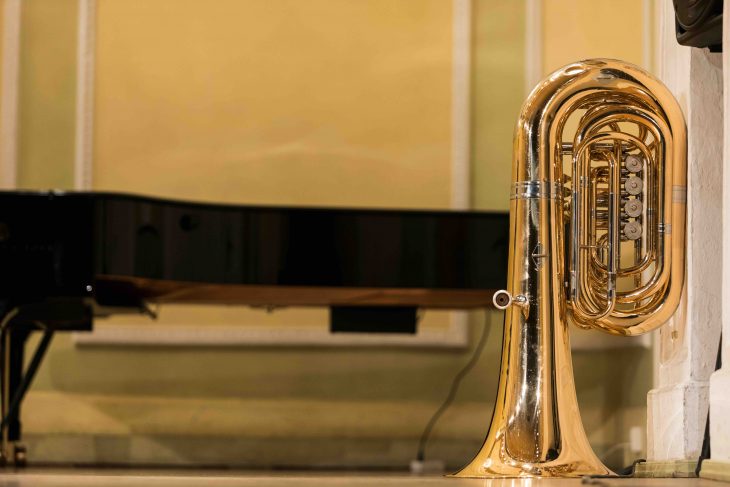
Whether you’re a passionate musician, a devoted band member, or simply an enthusiast of beautiful music, the tuba holds a special place in the world of brass instruments. With its deep, resonant tones and commanding presence, the tuba adds richness and depth to any musical composition. In this article, we explore 18 intriguing facts about the tuba that will deepen your appreciation for this majestic instrument.
The Tuba’s Ancient Roots
The tuba can trace its origins back to ancient civilizations. Its earliest ancestor, the Roman tuba, was a long, straight horn made of bronze or silver. The tuba evolved over the centuries, gradually transforming into the large, coiled instrument we know today.
A Member of the Brass Family
The tuba is a member of the brass family of instruments. It is made primarily of brass and produces sound by buzzing the player’s lips into a large cup-shaped mouthpiece.
The Mighty Bass Voice
As the largest and lowest-pitched instrument in the brass family, the tuba serves as the foundation of the brass section in orchestras and bands. Its deep, resonant tones provide a rich bass voice that complements and supports other instruments.
Various Types of Tuba
There are several types of tubas, including the standard or concert tuba, the sousaphone (often used in marching bands), and the euphonium (which is smaller and has a higher pitch). Each type possesses its own unique qualities and serves different musical purposes.
The Wagner Tuba
Contrary to its name, the Wagner tuba is not actually a tuba but a horn. It was created by Richard Wagner for his operas, such as “Der Ring des Nibelungen.” The Wagner tuba combines elements of both the horn and the tuba, producing a distinct and haunting sound.
Size Matters

Tubas come in various sizes, ranging from the compact “sousaphone” to the massive contrabass tuba. The larger the tuba, the lower the pitch it produces. The contrabass tuba, with its deep, thunderous sound, is often used for dramatic and powerful musical passages.
Crafting a Tuba
The construction of a tuba requires great skill and precision. The instrument is meticulously crafted by skilled artisans who shape and assemble the various components, including the bell, valves, slides, and mouthpiece. The choice of materials and the craftsmanship greatly influence the sound and playability of the instrument.
The Tubist’s Breathing Technique
Playing the tuba demands exceptional breath control. Tubists take deep, controlled breaths to sustain the instrument’s low tones and produce a continuous, resonant sound. Mastering this technique requires years of practice and discipline.
The Tubist’s Musical Range
While known for its deep, bass tones, the tuba is surprisingly versatile. Skilled tubists can produce a wide range of pitches, from low rumbling notes to soaring melodies. This versatility allows the tuba to adapt to various musical genres and styles.
The World’s Largest Tuba
The world’s largest playable tuba, known as the “subcontrabass tuba,” stands at an astonishing height of over 8 feet tall. It produces a mind-blowing low B-flat note, and its sheer size makes it a sight to behold.
Tuba’s Role in Jazz
Although the tuba is primarily associated with orchestras and marching bands, it has also found a place in jazz music. Jazz tubists employ their instrument to provide a strong rhythmic foundation and to add depth and texture to the ensemble’s sound.
Tuba Virtuosos
The tuba has its fair share of virtuosos who have showcased the instrument’s full potential. Artists like Harvey Phillips, Oystein Baadsvik, and Carol Jantsch have pushed the boundaries of tuba playing, demonstrating its expressive capabilities and technical prowess.
The Tuba’s Global Appeal
The tuba has gained popularity and recognition worldwide. It is an integral part of traditional brass bands in countries like the United Kingdom and Germany, where tuba festivals and competitions attract enthusiastic participants and audiences.
Tuba Fun Facts

Here are a few lighthearted facts about tubas: The term “tuba” comes from the Latin word for “trumpet,” and it was initially used to describe other instruments before becoming associated with the modern tuba. Additionally, the tuba is one of the few instruments that can play the famous “oom-pah” sound often associated with polka music.
Tuba Superheroes
The tuba has made appearances in popular culture, often in surprising and unexpected ways. It has been featured in films, such as “The Incredibles,” where the character Frozone uses his ice powers to create a tuba-like instrument to fight crime.
The Tuba’s Global Impact
Tubas have also become symbolic instruments of unity and peace. The renowned conductor Leonard Bernstein performed Beethoven’s Symphony No. 9 in Japan after World War II, and the inclusion of Japanese tuba players in the orchestra was seen as a powerful message of reconciliation.
Celebrating the Tuba
Tuba enthusiasts worldwide celebrate International Tuba Day on the first Friday of May each year. This day honors the instrument’s unique contribution to music and provides an opportunity for tuba players and fans to share their passion.
A Lifetime of Musical Joy
Finally, the tuba offers a lifetime of musical joy to those who embrace it. Whether played in a professional orchestra, a community band, or simply for personal enjoyment, the tuba’s deep and resonant tones create a profound and lasting impact on both players and listeners.
Final Word
The tuba is not only a powerful and majestic instrument but also a fascinating subject full of history and interesting facts. From its ancient origins to its global impact, the tuba continues to captivate musicians and audiences alike. So next time you hear the deep, melodic tones of a tuba, take a moment to appreciate the incredible craftsmanship and the rich musical heritage it represents.
Frequently Asked Questions (FAQs)
Are tubas difficult to play?
Playing the tuba requires dedication and practice, but with proper instruction and commitment, anyone can learn to play the tuba.
How heavy is a tuba?
The weight of a tuba can vary depending on its size and construction, but they generally range from 15 to 30 pounds (6.8 to 13.6 kg).
Can you play melodies on a tuba?
Yes, skilled tuba players can play melodies on the instrument. Despite being known for its deep bass sound, the tuba has a wide pitch range and can perform intricate melodies.
How much does a tuba cost?
The cost of a tuba can vary greatly depending on the brand, quality, and materials used. Entry-level tubas can start around $1,000, while professional-grade instruments can cost several thousand dollars.
Can children play the tuba?
While the tuba is a large instrument, children can learn to play it. Some manufacturers produce smaller-sized tubas specifically designed for younger players.
Was this page helpful?
Our commitment to delivering trustworthy and engaging content is at the heart of what we do. Each fact on our site is contributed by real users like you, bringing a wealth of diverse insights and information. To ensure the highest standards of accuracy and reliability, our dedicated editors meticulously review each submission. This process guarantees that the facts we share are not only fascinating but also credible. Trust in our commitment to quality and authenticity as you explore and learn with us.
